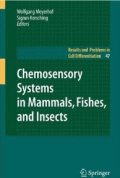|
|
|
|
Information about this site:
|
|
|
The author- or copyrights of
the listed Internet pages are held by
the respective authors or site
operators, who are also responsible for
the content of the presentations.
|
|
|
To include your website to the
Internetchemistry directory, please use
our
registration form or
send us an
eMail. |
Citation: |
www.internetchemistry.com/biochemistry/chemosensory.htm |
Entries: |
14 |
Topic: |
Chemosensory, Chemoreception (Chemosensors, Chemoreceptors) |
Keywords: |
Chemosensory, chemoreception, chemosensors, chemoreceptors, basic information, research |
Update: |
10.03.2012 00:00:00 [link check] |
|
10.03.2012 [site update] |
Chemistry information
not found? Try this form: |
|
|
|
Related Books and Scientific Literature: Chemosensory:
|
|

|
Wolfgang Meyerhof
Chemosensory Systems in Mammals, Fishes, and Insects
The sense of smell has varied roles in locating food, detecting predators, navigating, and communicating social information, whereas the taste system is focused on decision-making in food intake. The last decade has witnessed massive advances in understanding the molecular logic of chemosensory information processing, and the results for taste sensation were found to differ in interesting ways from those for smell sensation. The 12 chapters of this book cover the current knowledge about the chemosensory systems in mammalian, fish and insect models. The advantages of the different model systems are emphasized. The genomic characteristics and evolution of olfactory and gustatory receptor gene families are analyzed, rules for odorant receptor gene choice and axonal projection of the corresponding receptor neurons are discussed, and the similarities and dissimilarities of pheromone vs. odorant sensing are examined as well as the molecular logic of mammalian sweet taste, bitter taste, and fat perception. Olfactory-guided and taste-guided behaviors are discussed, with a particular emphasis on the insect system.
Springer; 2009
|
Internetchemistry ChemLin © 1996 - 2013 A. J.
|



